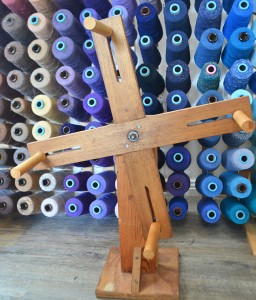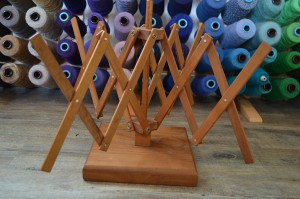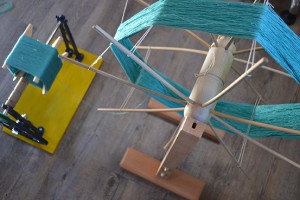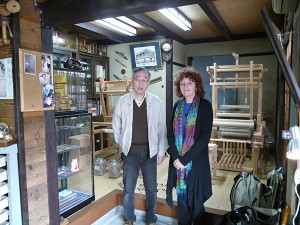It always seems a battle for a weaver to get skeins to yarn packages and back again. This has been a constant struggle for me over the years mainly because of a lack of variety and choice in coloured yarns for weavers in Australia and the finer yarns I tend to be attracted to. Many of the swifts on the market are designed for knitting yarns that are thicker and won’t tangle as much in the unwinding.

I have spent many, many 3 hour sessions unwinding a 2/60 hank of silk into a ball which then fails to run and gets knotted continuously when warping. I have tried the little ball winders that are great for 4ply knitting yarn and up – no good. I’ve tried winding cones on my electric bobbin winder – poor. The tension of the wind is also badly affected and leaves the yarn package in a poor starting state for nice loom tension.
I’ve also looked at production – getting things faster, more efficient…using more electricity – it has to be faster right now. But that makes even bigger knots and snaps. It’s enough to make you give up on weaving anything and slows you down so much before you even sit down at the loom.

So I try to buy yarn on cones then have other ways of introducing colour at the warping stage. But often that still leaves the weft…in a hank. So I’ve worked out ways around that too. But I’m always looking for a dream way of dealing with fine yarns.
So I’m now trying to replicate the system I learnt at Kawashima Textile School in Kyoto. Using fine yarns the journey from skein to yarn package (kiwaku) and back again is an essential and expected part of the whole process and is achieved with minimal tangling. The tools are more sensitive to this process. The tools are actually simpler than the ones I have. The Goko swift is made from what looks like the ubiquitous chopsticks and just string for holding the skein. That string is lightly supporting the whole frame and hank, which is barely touching the skein leaving little pressure for getting stuck. The swift is very light and the strings adjust to different sized skeins in a snap. The lightness can be managed by the ceramic ring which acts as a brake when the swift is rotating. Keeping it simple and manual. The kiwaku or Japanese wooden spool are the “cones”which wind up beautifully with a handwheel. No electricity and a time honored, thoroughly trialed equipment for what I need to do.

In retrospect over my many years of weaving I think I’ve unwittingly become thoroughly ensconced and entranced with weaving traditions from Europe, US and England which have climates and weaving traditions focusing on wool. The tools I use which stem from these traditions are mostly unquestioned because they are supposed do these basic winding tasks regardless of the fibres or yarn counts used. Conversely, in Asia much weaving is with silk or cotton and cellulose fibres which are generally spun much finer to suit the weather or textile traditions. There is a big difference between these tools which the eye or an intellectual assumption won’t realise. It’s in the actual doing where these subtle differences really count. Question your tools – where do they come from, what was their main traditional use, do they work for you and your work, what type of work were the tools developed for? Look to and consider simplicity in tools or if complexity and power supply will assist you to create what you want. Tools that are used in traditional high skill work will often work better for small studio production. It’s helpful to think about these things even if you decide they aren’t relevant to your situation.

The Goko Swift and Kiwaku winder are available from Inagaki Kiryou in the textile district in Kyoto Japan. I was able to meet the maker on a visit to the store in 2010. An amazing shop and a true weaver’s paradise.
I’m interested in your solutions to the knotty and snaggy hazards of being a weaver.

Leave a Reply